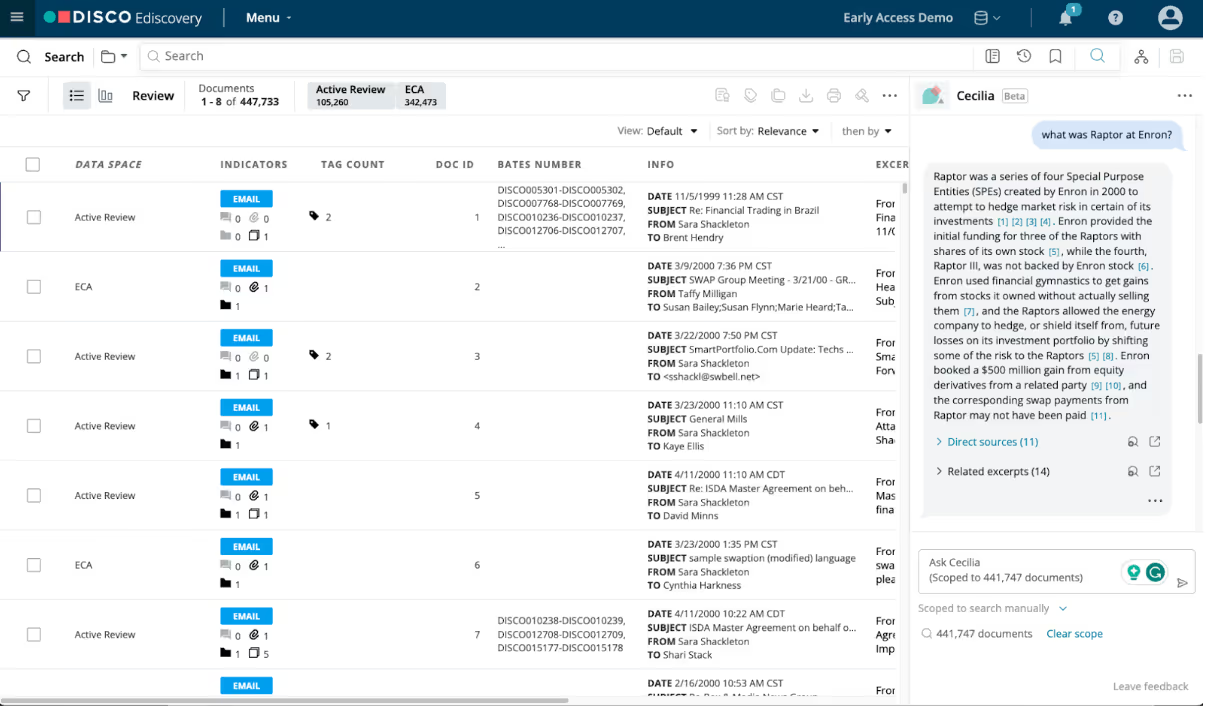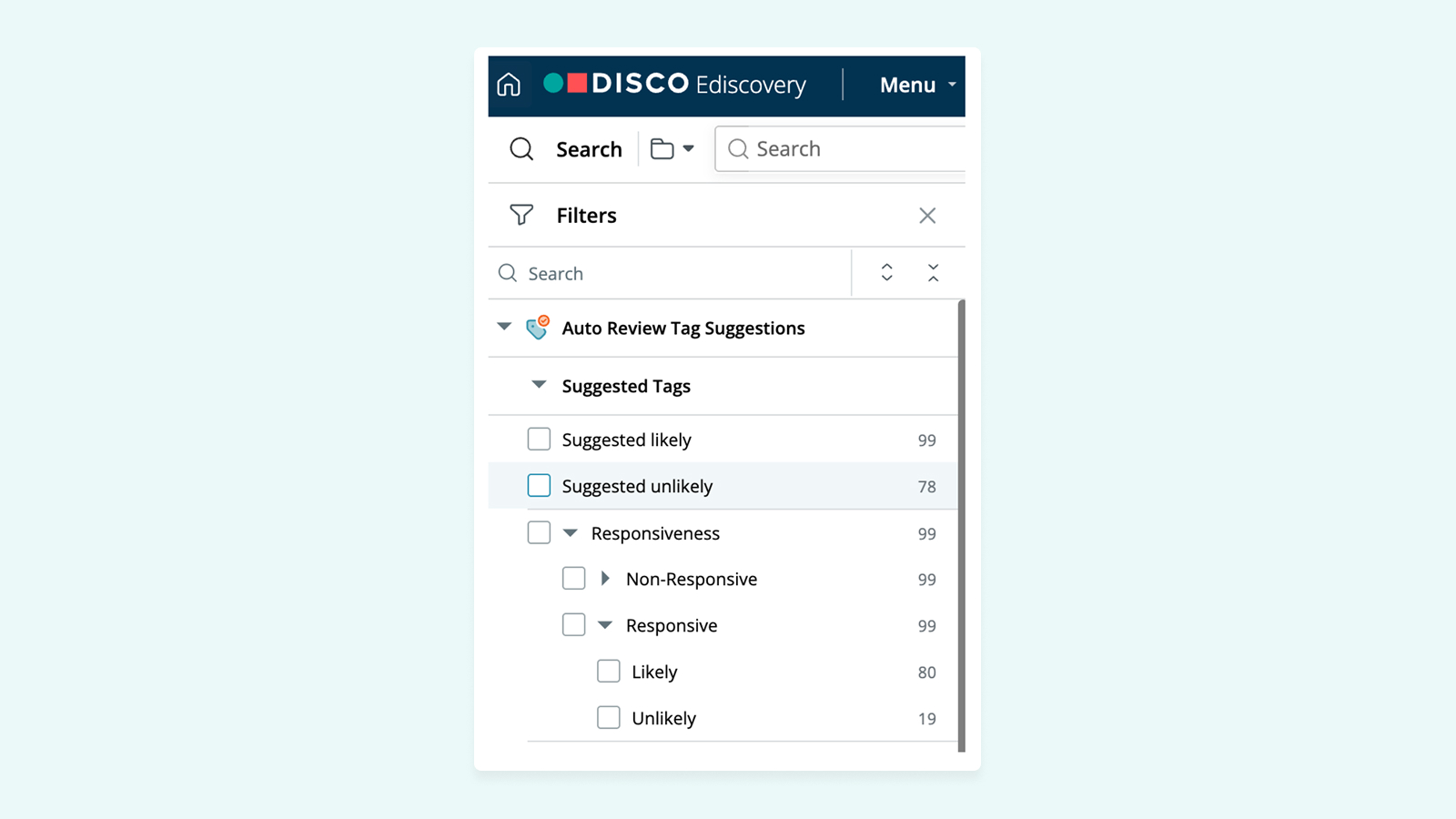⚡️ 1-Minute DISCO Download
If you’ve used Technology-Assisted Review (TAR 1.0 and 2.0), a court-approved mainstay of ediscovery, great news: You’re already using artificial intelligence for litigation.
For more than a decade, attorneys have leveraged AI for topic clustering, sentiment analysis, and more. The legal space, clearly, is no stranger to AI. However, recent advancements have unleashed a wave of potential new AI applications in litigation. Generative AI (GenAI) is poised to play a pivotal role in the immediate future of legal work. In this article, I’ll break down what it looks like to use generative AI for fact analysis and investigation – including features, benefits, risks, examples, and how to get started.
Why use generative AI for fact analysis and investigation?
Unlike document prioritization – which uses machine learning to quickly surface documents for human review – generative AI assists an attorney by parsing information and answering questions by using natural language: for example, organizing a large set of documents into a timeline of events, or addressing a query with a fully-cited summary of the relevant evidence or case law.
Key features of generative AI for fact analysis and investigation
- Synthesizing information
- Fact extraction and verification
- Misinformation detection
- Due diligence
- Testimony and evidence authentication
- Real-time fact monitoring
1. Synthesizing information
Generative AI is adept at rapidly parsing through extensive datasets and synthesizing the information to be specifically helpful to attorneys.
It can work across entire ediscovery databases or down-selected groups of documents, easily and precisely extracting and highlighting the desired content. This is the kind of fact identification that would normally take a vast amount of manual work for a human attorney.
In short, generative AI can critically enhance attorneys’ efficiency, speed, accuracy, and ability to uncover pivotal points of fact.
2. Fact extraction and verification
Generative AI is excellent at extracting information, like dates, names, and locations. It can also help you verify their accuracy by cross-referencing the information with with known data, official records, or applicable laws – and provide linked citations to the sources, enabling human attorneys a second layer of verification.
User verification is critical when using GenAI, as the technology has the ability to “hallucinate,” or confidently present information as fact that is not actually true. Always check the cited sources and verify independently — especially when the accuracy of those facts could shape case strategy or negotiations.
Related read: Reality Check: How to Navigate AI Hallucinations
Note: While GenAI can be incredibly useful for research and fact-checking, you should never upload sensitive or confidential documents to free GenAI tools that may train on your data or share the information with other users. DISCO’s Cecilia and Auto Review tools keep your data secure and private – your information is never used to train our model. Learn more here.
3. Misinformation detection
Misinformation can hide in plain sight. Generative AI can help root it out by analyzing patterns in language, tone, and logic to flag inconsistencies or signs of manipulation in documents, testimony, or contracts.
While this tool is helpful, note that sophisticated misinformation or forgery might still bypass current AI detection capabilities. Furthermore, AI itself can sometimes be a source of misinformation if not properly managed, as referenced above. So consider the primary role of GenAI here as an assistant to flag potential issues, not as a definitive arbiter of truth or authenticity.
4. Due diligence
Generative AI streamlines due diligence by analyzing litigation histories, public records, and corporate filings to spot hidden liabilities, undisclosed conflicts, or past fraudulent activity.
By offloading this work from legal teams, AI enables legal teams to mitigate risks and ensure compliance more efficiently.
5. Testimony and evidence authentication
GenAI can be a powerful tool to help attorneys swiftly and easily cross-reference witness statements, expert opinions, and documentary evidence with established research and legal precedents. This helps spot anomalies and flag potentially unreliable or fabricated statements, assisting attorneys in authenticating testimony.
This level of automated scrutiny gives attorneys a stronger footing when preparing arguments, challenging witness reliability, and deciding which evidence to prioritize.
6. Monitoring legal and regulatory changes
Generative AI assists attorneys in keeping pace with the evolving legal landscape by monitoring specified legal databases, government filings, and other sources for new developments. It can help filter these updates for relevance and provide timely summaries or alerts regarding case law changes, emerging industry shifts, or new regulatory requirements.
This is particularly beneficial for maintaining compliance and informing strategy, though – as always – all AI-identified changes require expert human interpretation and validation.
💡Bonus: How to Use Generative AI for Drafting Documents and Briefs
Benefits of AI for investigative analysis and legal fact checking
- Fast, accurate fact extraction from legal documents and testimonies
- Detection of inconsistencies in contracts, statements, and evidence
- Automated fact-checking and case summarization for legal research
- Pattern recognition to strengthen arguments and detect fraud
- Real-time fact monitoring to stay updated on case developments
Generative AI-powered fact analysis and investigation in action
In this example scenario, a manufacturing company, Vandelay Widgets, Inc. (VWI), has experienced a high number of contractual disputes with their customers in the past two years.
The customers are accusing VWI of selling them shoddily constructed widgets, which break down faster than expected. As part of the investigation, VWI collected a large set of data, sourcing communications across many custodians.
Step 1: Timeline generation
VWI’s legal team or its outside counsel can use a generative AI tool to construct a comprehensive timeline of events, with citations and links to each relevant source. From this, the attorneys can begin to understand when the alleged complaints began, and the sequence of internal communications regarding the construction of the widgets.
Having this laid out early in their investigation enables the attorneys to construct a better strategy sooner.
Related read: Elevating Legal Strategy: The Importance of Timelines, and the Advantage of Organizing Them by Facts
Step 2: Interrogating the evidence
With timeline in hand, VWI’s legal team or its outside counsel can then ask a generative AI tool to answer specific questions about the case. These queries can be scoped across the entirety of the document collection, or across a subset of it, such as the email collection of a specific custodian.
For instance, the team can ask, “What did the CEO say about the quality of the widgets?” The AI tool will deliver a thorough summary of every relevant communication, with linked citations to visually highlighted quotes – well-written, and virtually ready to use in a memorandum or brief (but always check the sources!).
This will enable the legal team or outside counsel to advise VWI on how best to proceed, both in addressing customers’ existing complaints and in preventing future disputes.
💡Related reading: Robots v. Rube Goldberg Machines: How AI Helps Solve The Precision and Recall Gap
Generative AI for fact analysis and investigation: Challenges and solutions
Challenge: Hallucinations
A common concern legal teams have about generative AI is hallucinations – outputs that might seem plausible, but aren't accurate or real.
In plain English: Generative AI will sometimes say things that are factually wrong. In the context of fact investigation, this is a significant (but known) risk.
Solution: Verify, verify, verify
One option is to conduct independent research. A more expedient solution is to choose a generative AI tool that cites its sources.

Challenge: Selecting the right tool and integrating it into your workflows
Everyone who has ever purchased new technology for their firm has experienced this. You select a product to maximize efficiency and accuracy. You purchase it and spend lots of resources implementing it… only to find that no one is actually using it.
This can be especially true of products that rely on new technology – which can be perceived as unfamiliar, untested, or intimidating.
You must decide how you will integrate this new technology into your practice. Should you build a dedicated large language model (LLM) for your firm’s direct use, or buy one? Or should you contract an external legal services provider that runs its own AI shop?
It comes down to the common business choice: build, buy, or partner.
Solution: Prioritize smart, flexible integrations
Buying ready-made AI models offers immediate time-saving advantages – but may not be tailored to the specific needs of your firm. On the flip side, building and training your own in-house model offers deeper customization – but requires time, firm resources, and expertise.
One solution is to go hybrid: Immediately leverage the speed and efficiency of ready-made generative AI solutions while investing in the development of bespoke elements where needed.
For many, the optimal choice is to partner with a generative AI provider that offers a customizable platform. Rather than having to dedicate in-house resources to building out your model, you can simply work with a provider who will handle the heavy tech lift and create a system that will fit the unique workflows and requirements of your firm.
Adopting generative AI for fact analysis and investigation: Actionable next steps
1. Conduct an in-depth assessment of your firm’s needs before deciding whether to build, buy, or partner with a provider for a generative AI solution
Mike Wong, DISCO RSE, recommends that if you’re planning on implementing generative AI tools into your law firm, “Be cautious of software that has risen quickly. Ask lots of questions of the supplier – and, even better, confirm that they’re using the tech in-house, too.”
2. Emphasize continuous learning and create a tech-friendly culture within your firm.
The key is to help legal professionals grow more comfortable with new technology such as AI. Regular workshops, seminars, and training sessions can help bridge the knowledge gap and simplify complex generative AI concepts.
When attorneys understand the gains in efficiency and fast, dependable insights, they will be more motivated to use the new tools.
Get to the facts faster with DISCO’s Cecilia
Ready to introduce generative AI into your fact analysis and investigation workflows? DISCO is here to help.
DISCO’s category-leading ediscovery platform is easy to use, with intuitive search, sophisticated ingest and overlay tools, and airtight security. And now, DISCO’s Cecilia AI takes litigation to the next level with the following features:
- Cecilia Q&A - your in-platform AI fact expert that can answer any question about your case documents
- Cecilia Timelines - auto-generate legal timelines that summarize key facts
- Cecilia Doc Summaries - ask natural language questions and receive clear, well-written answers
- Cecilia Auto Review – automate your document review using generative AI
See how we can transform your practice: Request a demo.
Sections of this article come from our downloadable ebook, Generative AI for Litigation: What You Really Need to Know.







%20(1).jpeg)






.png)

